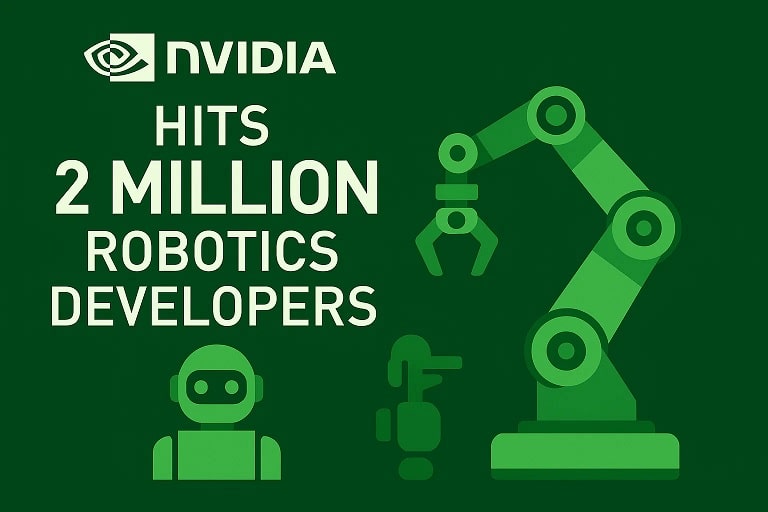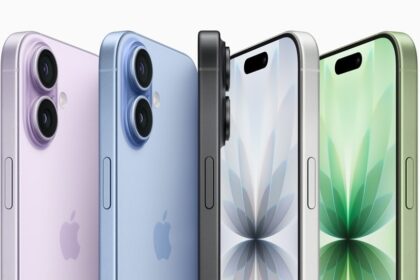NVIDIA Hits 2 Million Robotics Developers Milestone: A Deep Dive into the Robotics Revolution
August 19, 2025 NVIDIA, a global leader in AI and accelerated computing, announced on August 18, 2025, that over 2 million developers are now utilizing its robotics stack, marking a significant milestone in the company’s push to transform industries through AI-powered robotics. This achievement, driven by the NVIDIA Jetson platform and an expansive ecosystem, underscores the growing adoption of edge AI across sectors like manufacturing, healthcare, agriculture, and logistics. This article provides a comprehensive analysis of this milestone, detailing NVIDIA’s robotics journey, key technologies, industry impact, and future implications, with data presented in tables and answers to common questions in an FAQ section.
Overview of the Milestone
NVIDIA’s robotics stack, encompassing hardware like the Jetson platform and software suites such as NVIDIA Isaac, has attracted over 2 million developers since the Jetson’s debut in 2014. The ecosystem now includes more than 150 hardware, software, and sensor partners, enabling over 7,000 customers to deploy AI-driven solutions globally. The latest Jetson Thor platform, tailored for physical AI and humanoid robotics, integrates with mainstream AI frameworks and generative AI models, amplifying its appeal. This milestone reflects NVIDIA’s strategic shift from gaming and GPUs to becoming a cornerstone of the robotics and AI revolution.
The announcement, made at the SIGGRAPH 2025 conference, highlights the rapid growth of NVIDIA’s developer community, fueled by tools like NVIDIA Isaac for simulation, GR00T for humanoid robot models, Metropolis for vision AI, and Holoscan for real-time sensor processing. Companies like Peer Robotics, Serve Robotics, and Universal Robots are leveraging these tools to innovate in automation, addressing labor shortages and enhancing efficiency.
Historical Context: NVIDIA’s Robotics Evolution
NVIDIA’s journey in robotics began with the Jetson TK1 in 2014, a compact platform designed to bring AI to the edge. Initially rooted in gaming and GPU technology, NVIDIA pivoted toward AI and robotics in the early 2010s, recognizing the potential of deep learning. By 2015, the company expanded its focus to edge computing and autonomous systems, with the Isaac SDK (2019) marking a pivotal step in unifying AI perception, simulation, and manipulation capabilities.
The developer count grew exponentially, from 1 million in 2018 to 2 million by 2025, driven by CUDA’s accessibility and the open-source integration of Isaac ROS with ROS 2, which empowered millions in the Robot Operating System community. The Jetson Thor, launched in 2024, further solidified NVIDIA’s leadership by offering specialized hardware for humanoid robots and industrial automation.
Detailed Breakdown of NVIDIA’s Robotics Ecosystem
Key Components
- Jetson Platform: From TK1 to Thor, Jetson provides low-power, high-performance computing for edge AI, supporting applications from autonomous mobile robots (AMRs) to humanoids. Thor integrates with generative AI models, enhancing adaptability.
- NVIDIA Isaac: A suite for simulation, development, and deployment, including:
- Isaac ROS: Modular packages for ROS 2 developers, accelerating AI workflows.
- Isaac Sim: A simulation platform for testing robots in virtual environments.
- Isaac Perceptor: Multi-camera vision for AMRs.
- Isaac Manipulator: AI-driven control for robotic arms.
- GR00T Foundation Model: A customizable model for humanoid robots, combining fast (reflexive) and slow (deliberate) reasoning systems, trained on synthetic and human data.
- Omniverse and Cosmos: Platforms for creating photorealistic 3D simulations and synthetic data, with Cosmos WFMs downloaded over 2 million times for robot training.
- Holoscan and Metropolis: Real-time sensor processing and vision AI for robotics and smart cities.
Developer Ecosystem
The 2 million developers include researchers, startups, and industry leaders across North America, Asia, and Europe. Notable adopters include Siemens, BYD Electronics, and Boston Dynamics, who use NVIDIA’s tools for tasks like autonomous logistics and pick-and-pack automation. The NVIDIA Developer Program provides access to SDKs, training, and funding, fostering innovation.
Industry Applications
- Manufacturing: KUKA and Standard Bots use Isaac Sim for robotic arms, improving efficiency in automotive and logistics.
- Healthcare: Diligent Robotics deploys AI-powered assistants for repetitive tasks.
- Logistics: Serve Robotics and BYD Electronics leverage Isaac Perceptor for AMRs in warehouses.
- Humanoids: Companies like 1X and Figure AI use GR00T for robots tackling labor shortages.
In-Depth Analysis: Trends and Implications
Growth Drivers
- AI Advancements: Generative AI and vision-language models enable robots to adapt to dynamic environments, reducing reliance on preprogrammed behaviors.
- Simulation Revolution: Isaac Sim and Omniverse allow developers to train robots in virtual worlds, cutting costs and deployment times from months to days.
- Open Ecosystem: Integration with ROS 2 and open-source tools like MuJoCo-Warp democratizes access, attracting millions.
- Labor Shortages: With a global shortage of over 50 million workers, industries are turning to automation, boosting demand for NVIDIA’s platforms.
Challenges
- Complexity: Developing humanoids requires vast data and computational resources, posing barriers for smaller players.
- Simulation-to-Reality Gap: While simulations are powerful, real-world variables like lighting or surface friction can reduce accuracy.
- Cost: Despite NVIDIA’s efforts to lower barriers, high-end hardware like Jetson Thor remains expensive for startups.
Future Projections
By 2030, NVIDIA aims to power a significant portion of the global robotics market, projected to reach $1 trillion. The focus on humanoids and physical AI could see robots in homes within a decade, though experts caution that consumer humanoids are still years away. Advances in synthetic data generation and cloud-native services like OSMO will further accelerate development cycles.
NVIDIA Robotics Milestones (2014-2025)
Year | Milestone | Details | Impact |
|---|---|---|---|
| 2014 | Jetson TK1 Launch | Introduced edge AI platform. | Sparked robotics developer community. |
| 2019 | Isaac SDK Release | Unified AI perception and simulation. | Accelerated robot development. |
| 2020 | 2M Developer Program | Reached 2 million registered developers across all NVIDIA platforms. | Highlighted broader AI adoption. |
| 2024 | Jetson Thor & GR00T | Platforms for humanoid robotics. | Positioned NVIDIA as a leader in physical AI. |
| 2025 | 2M Robotics Developers | Over 2 million using robotics stack. | Solidified robotics ecosystem growth. |
Key NVIDIA Robotics Platforms (2025)
Platform | Function | Key Features | Industries Served |
|---|---|---|---|
Jetson Thor | Edge AI Computing | Supports generative AI, ROS 2 integration. | Humanoids, AMRs, logistics. |
Isaac Sim | Simulation | Physically accurate virtual testing. | Manufacturing, healthcare. |
GR00T N1 | Humanoid AI | Dual-system reasoning, synthetic data training. | Humanoids, material handling. |
Omniverse/Cosmos | Synthetic Data | 3D simulation, 2M+ downloads of WFMs. | Robotics, autonomous vehicles. |
FAQs
How many developers use it?
Over 2 million developers globally, as of August 2025.
What industries benefit?
Manufacturing, healthcare, logistics, agriculture, and more, with applications like AMRs and humanoids.
Why is the Jetson platform significant?
Launched in 2014, it enables edge AI for robotics, with Thor being the latest model for humanoids.
What is Isaac GR00T?
A foundation model for humanoid robots, featuring dual-system AI for reasoning and movement.
How does simulation help?
Tools like Isaac Sim allow developers to train robots in virtual environments, reducing costs and time.
What are the challenges?
High costs, simulation-to-reality gaps, and data demands for complex robots like humanoids.
What’s the role of Omniverse?
It generates photorealistic 3D simulations and synthetic data for robot training.
How big is the ecosystem?
Over 150 partners and 7,000 customers, with 2 million developers.
What’s next for NVIDIA robotics?
Expansion into consumer humanoids and deeper integration with generative AI by 2030.













